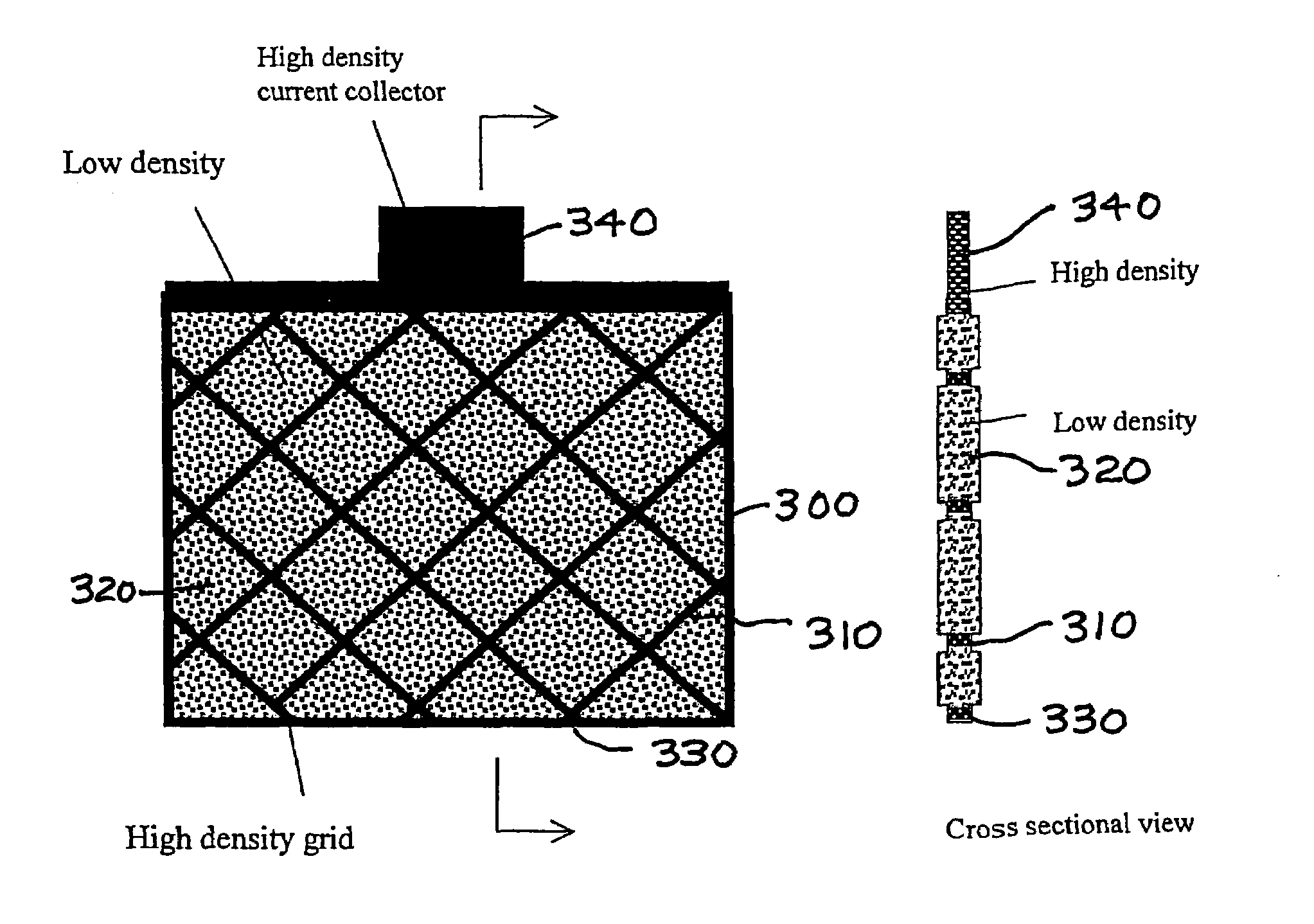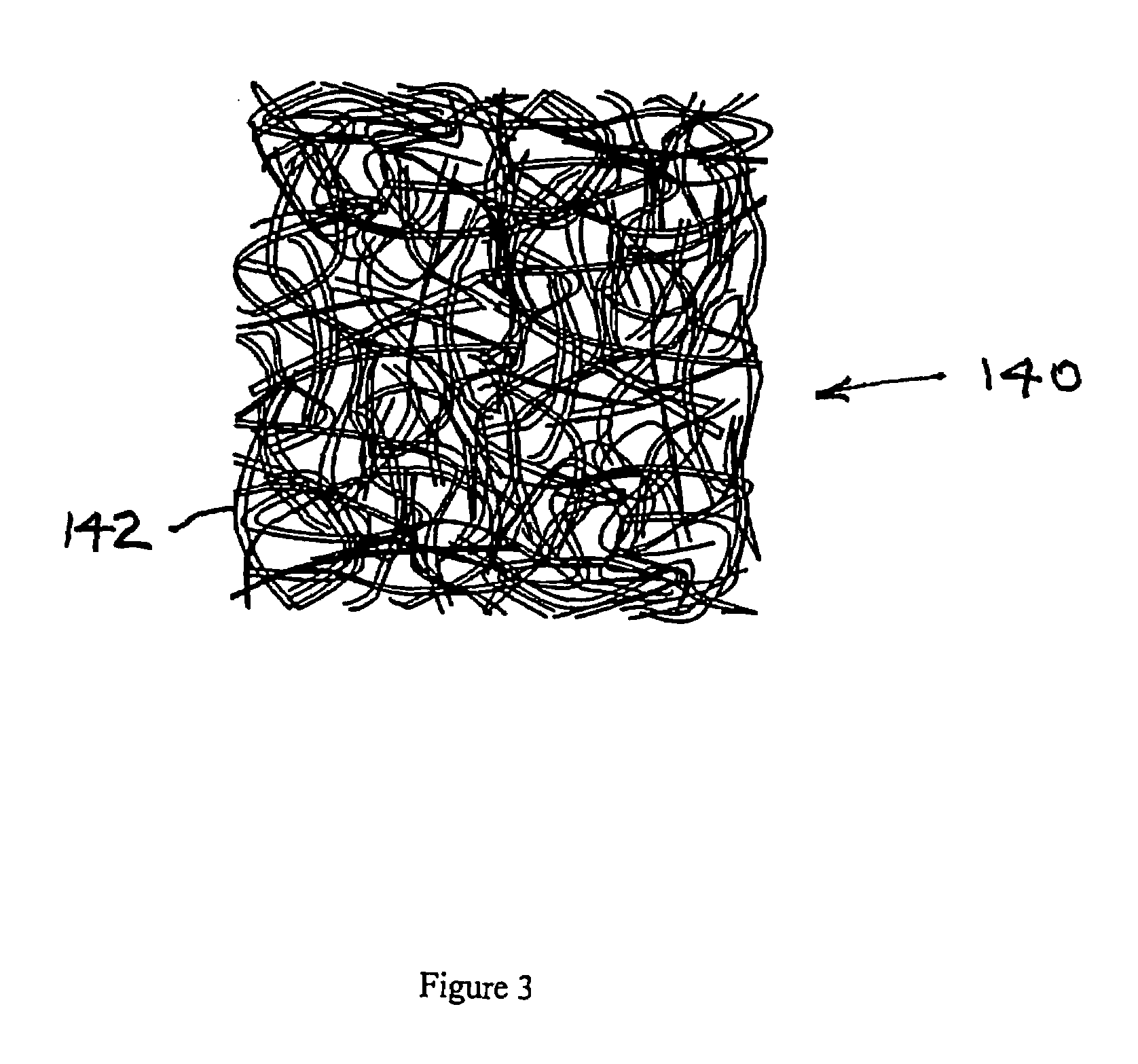Solid porous zinc electrodes and methods of making same
a technology electrodes, applied in the field of solid porous zinc electrodes, can solve the problems of high activity, high battery power, and powder that performs well in one battery design
- Summary
- Abstract
- Description
- Claims
- Application Information
AI Technical Summary
Benefits of technology
Problems solved by technology
Method used
Image
Examples
example 1
[0096]A group of commercial alkaline C cells marketed by a major battery manufacturer were purchased within three weeks of each other with expiry dates of 2010. The original commercial cells were cut from the top and the zinc anode paste (zinc powder and KOH gel) was removed. The weight of the four solid porous anodes was in the range between 10.20 g and 12 g. The electrolyte added into the testing cell was 8.4 g of 35% KOH. A solid electrode was formed by first pressing zinc wools on a layer of plastic wool mesh into a sheet of 37 mm in width, 90 mm in length and about 2 mm in thickness. The layer of fabric mesh prevented the broken zinc wools from falling off the electrode during the step when the zinc wool sheet was rolled to a diameter of about 15 mm. The rolled anode was wrapped in a piece of separator and inserted into the cell cavity. The wool used was an alloy with 500 ppm Bi and had a near rounded cross-section of average diameter of about 70 μm and a nominal length of 1.8 ...
example 2
[0098]This example demonstrates the application of solid porous wooly zinc electrodes for a zinc-air cell. In this test, the solid porous wooly zinc electrode weighed 9.7 g and was a plate with dimensions of 4.5 cm×6.5 cm×0.3 cm, which was pressed with a zinc wool alloyed with 500 ppm Bi. The electrode had a density of 1.1 g / cm3 and porosity of 84.7%. The anode was fully immersed in 12.8 g of 35% KOH in an in-house made cell. FIG. 17 shows a graphical illustration of a discharging curve of a zinc-air cell with a solid porous zinc anode at a constant current of 1 A. As shown in FIG. 17 with discharging of the solid porous electrode at a constant current of 1 A, the total discharging time to cut off voltage of 0.8 V was 7.2 hours thereby giving a capacity of 7.2 Ah. The theoretical value for zinc is 0.82 Ah / g. Thus, the material utilization efficiency was 91%.
example 3
[0099]This example further illustrates the improved performance of a solid porous wooly zinc electrode under a diverse range of materials, processing and anode design conditions. Commercial cells were supplied by a major battery manufacturer with expiry dates of 2010 and were tested within four weeks of purchase. In this example, original commercial cells were cut from the top and the zinc anode paste (zinc powder and KOH gel) was removed. The weight of the four solid porous anodes was in the range between 9.9 g and 10.9 g. The electrolyte was 35% KOH and an amount of 7.5 to 8.3 g was added into the testing cells. The fibrous wool used was an alloy of zinc with Bi, or zinc and In or Zinc with Bi and In, having a near rounded cross-section of average diameter of about 70 μm and a nominal length of 1.8 cm. The discharge was conducted at a constant current of 1 A and at room temperature of 22° C. One anode was made by pressing the wooly material in a mold. Another anode was rolled from...
PUM
| Property | Measurement | Unit |
|---|---|---|
| density | aaaaa | aaaaa |
| density | aaaaa | aaaaa |
| density | aaaaa | aaaaa |
Abstract
Description
Claims
Application Information
 Login to View More
Login to View More - R&D
- Intellectual Property
- Life Sciences
- Materials
- Tech Scout
- Unparalleled Data Quality
- Higher Quality Content
- 60% Fewer Hallucinations
Browse by: Latest US Patents, China's latest patents, Technical Efficacy Thesaurus, Application Domain, Technology Topic, Popular Technical Reports.
© 2025 PatSnap. All rights reserved.Legal|Privacy policy|Modern Slavery Act Transparency Statement|Sitemap|About US| Contact US: help@patsnap.com



